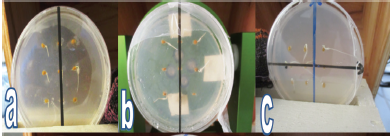GROWTH AND ANATOMICAL RESPONSES OF TOMATO (LYCOPERSICON ESCULENTUM ) UNDER MICROGRAVITY AND NORMAL GRAVITY CONDITIONS
Mots-clés :
anatomy, clinostat, germination, microgravity, Lycopersicon esculentumRésumé
Microgravity is known to be a major abiotic stress in space which affects plants depending on the duration of
exposure. In this research, tomato seeds were exposed to long hours of simulated microgravity condition using
a one-axis clinostat. The seeds were sown on a 1.5% combination of plant nutrient and agar-agar solidified
medium in three Petri dishes. One of the Petri dishes was mounted on the clinostat and allowed to rotate at
the speed of 20 rpm for 72 hours while the others were subjected to the normal gravity vector. The anatomical
sections of both clinorotated and normal gravity plants were made after 72 hours and observed using a Phase
contrast digital microscope. The percentage germination as well as the growth rate of the normal gravity seeds was higher than the clinorotated treatments. The orientation of the clinorotated roots during germination were in different directions unlike the normal gravity which all germinated towards the direction of gravity vector. The clinostat was able to switch off gravistimulation as distinct cellular arrangement was observed for the tomato plants under normal gravity condition unlike those of the clinorotated treatment. The results revealed that the thickness of the epidermis and cortex of the roots of normal gravity are higher than those of clinorotated. This suggests that under long-term microgravity exposure, plants can acclimatize to the stress by changing their internal cellular features such as reduction in the thickness of cells and rate of cell proliferation.
##plugins.themes.default.displayStats.downloads##





